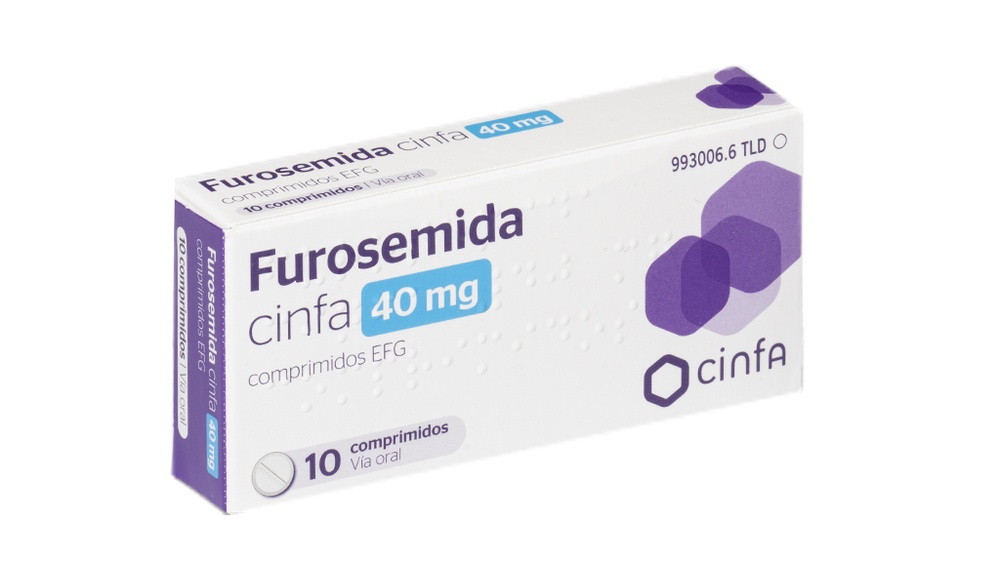

FUROSEMIDE CINFA 40 mg TABLETS

Ask a doctor about a prescription for FUROSEMIDE CINFA 40 mg TABLETS

How to use FUROSEMIDE CINFA 40 mg TABLETS
Introduction
Package Leaflet: Information for the User
Furosemide Cinfa 40 mg Tablets EFG
Read all of this leaflet carefully before you start taking this medicine because it contains important information for you.Keep this leaflet. You may need to read it again.
- Keep this leaflet, you may need to read it again.
- If you have any further questions, ask your doctor or pharmacist.
- This medicine has been prescribed for you only. Do not pass it on to others. It may harm them, even if their signs of illness are the same as yours.
- If you get any side effects, talk to your doctor or pharmacist. This includes any possible side effects not listed in this leaflet. See section 4.
Contents of the pack
- What is Furosemide Cinfa and what is it used for
- What you need to know before you take Furosemide Cinfa
- How to take Furosemide Cinfa
- Possible side effects
- Storage of Furosemide Cinfa
- Contents of the pack and other information
1. What is Furosemide Cinfa and what is it used for
Furosemide Cinfa is a diuretic belonging to the group of sulfonamides. It acts by increasing urine elimination (diuretic) and reducing blood pressure (antihypertensive).
Always under the prescription of your doctor, this medicine is indicated for the treatment of:
- Edema (swelling due to fluid accumulation) associated with congestive heart failure, liver cirrhosis (ascites), and kidney disease, including nephrotic syndrome (priority is given to the treatment of the underlying disease).
- Edema following burns.
- Mild to moderate arterial hypertension.
2. What you need to know before you take Furosemide Cinfa
Do not take Furosemide Cinfa
- If you are allergic to furosemide, to medicines belonging to the group of sulfonamides, or to any of the other components of this medicine (listed in section 6).
- In case of decreased total blood volume (hypovolemia) or dehydration.
- If you have severe kidney problems, accompanied by a decrease in urine elimination (renal insufficiency with anuria), that do not respond to this medicine.
- If you have a severe decrease in potassium levels in the blood (severe hypokalemia) (see section 4 "Possible side effects").
- If you have a severe deficiency of sodium salts in the blood (severe hyponatremia).
- In case of pre-coma and coma associated with hepatic encephalopathy.
- If you are breastfeeding a baby.
If you are pregnant, see the "Pregnancy, breastfeeding and fertility" section.
Warnings and precautions
Consult your doctor or pharmacist before starting to take Furosemide Cinfa.
Be especially careful with this medicine:
- If you have problems with urine elimination, especially at the start of treatment.
- If your blood pressure is low (hypotension).
- If you are at special risk of suffering a pronounced drop in blood pressure (for example, in patients with significant coronary or cerebral stenosis).
- If you have latent or manifest diabetes mellitus.
- If you suffer from gout.
- If you have severe kidney problems associated with severe liver disease (hepato-renal syndrome).
- If your blood protein levels are low (hypoproteinemia), in addition to suffering from, for example, nephrotic syndrome (see section 4 "Possible side effects").
- In premature children (see section 4 "Possible side effects").
- There is a possibility of exacerbation or activation of systemic lupus erythematosus.
- If you are an elderly person, if you are being treated with medicines that can cause a decrease in blood pressure or if you have other medical conditions that have associated risk of decreased blood pressure.
During treatment with this medicine, periodic monitoring of your blood levels of sodium, potassium, and creatinine will generally be required, especially if you suffer from severe fluid loss, due to vomiting, diarrhea, or intense sweating. Dehydration or hypovolemia, as well as any significant electrolyte and acid-base imbalance, should be corrected. Treatment interruption may be required.
Elderly patients with dementia who are taking risperidone should be especially careful when using risperidone and furosemide concomitantly. Risperidone is a medicine used to treat certain mental illnesses, such as dementia (a disease characterized by several symptoms: memory loss, speech problems, thinking problems).
Use in athletes
This medicine contains furosemide, which can produce a positive result in doping tests.
Taking Furosemide Cinfa with other medicines
Tell your doctor or pharmacist if you are taking, have recently taken, or might take any other medicines.
The effect of treatment may be affected if furosemide is used at the same time as other medicines.
Some substances may increase their toxicity in the ear and kidneys if administered together with this medicine. Therefore, they should only be administered together if there are medical reasons that require it:
These substances include:
- Aminoglycoside antibiotics (infection medicines) such as gentamicin, kanamycin, and tobramycin.
- Cancer medicines (cisplatin).
The concomitant use of furosemide with other medicines may weaken the effect of these medicines, such as:
- Medicines used for diabetes (antidiabetics).
- Medicines used to increase blood pressure (sympathomimetics with a hypertensive effect, for example, epinephrine and norepinephrine).
In other cases, concomitant use may increase the effects of these medicines, such as:
- Asthma medicines (theophylline).
- Muscle relaxants such as curare.
- Depression medicines (lithium salts): may increase the risk of lithium toxicity, including the risk of harmful effects on the heart or brain.
- Patients undergoing treatment with diuretics may suffer from severe hypotension and deterioration of kidney function, especially when an ACE inhibitor (Angiotensin-Converting Enzyme) or an angiotensin II receptor antagonist is administered for the first time or a high dose is administered for the first time.
- If medicines to treat high blood pressure, diuretics, or other medicines that can decrease blood pressure are administered together with furosemide, a more pronounced drop in blood pressure should be expected.
- Nephrotoxic medicines: concomitant administration may potentiate the harmful effect of these medicines on the kidneys.
Some medicines for inflammation and pain (non-steroidal anti-inflammatory drugs, including acetylsalicylic acid) and medicines for epilepsy (phenytoin) may reduce the effect of furosemide.
Furosemide may increase the toxicity of salicylates.
This medicine and sucralfate should not be administered together, with an interval of less than 2 hours, as the effect of furosemide may be reduced.
Medicines such as probenecid and methotrexate or other medicines that have significant renal elimination may reduce the effect of furosemide. In high-dose treatment, they may increase serum levels and increase the risk of side effects due to furosemide or concomitant administration.
The following substances may increase the risk of reducing potassium levels in the blood (hypokalemia) if administered with furosemide:
- Anti-inflammatory medicines (corticosteroids).
- Carbenoxolone (medicine for the treatment of oral mucosa lesions).
- Large amounts of licorice.
- Prolonged use of laxatives for constipation.
Some electrolyte disturbances (for example, decreased potassium or magnesium levels in the blood) may increase the toxicity of some medicines (for example, digitalis medicines and medicines that induce QT interval prolongation syndrome).
Patients undergoing treatment with furosemide who receive high doses of certain cephalosporins (antibiotics) may suffer from decreased kidney function.
The concomitant administration of furosemide and cyclosporin A (a medicine used to prevent transplant rejection) is associated with an increased risk of gouty arthritis (joint inflammation) secondary to increased blood urea levels and kidney urea elimination problems.
Those patients at high risk of suffering from nephropathy (kidney disease) due to contrast media who receive furosemide are more likely to suffer from kidney function deterioration.
The administration of furosemide together with risperidone in elderly patients with dementia could increase mortality.
High doses of furosemide administered with levothyroxine may lead to a transient initial increase in free thyroid hormones, followed by a general decrease in total thyroid hormone levels.
Your doctor may need to change your dose and/or take other precautions if you are taking one of the following medicines:
- Aliskiren - used to treat high blood pressure.
Pregnancy, breastfeeding and fertility
If you are pregnant or breastfeeding, think you may be pregnant or are planning to have a baby, ask your doctor or pharmacist for advice before taking this medicine.
If you are pregnant, you will only use furosemide if there are medical reasons that require it.
During breastfeeding, do not administer furosemide. In the case that its administration is essential, your doctor may require you to interrupt breastfeeding, as furosemide passes into breast milk.
Driving and using machines
This medicine may cause dizziness or drowsiness. This can happen more often at the start of treatment, when your doctor increases the dose, or if you consume alcohol. Do not drive or use tools or machines if you feel dizzy or drowsy.
Some side effects (e.g., a pronounced undesirable drop in blood pressure) may impair your ability to concentrate and react, and therefore constitute a risk in situations where these skills are especially important (e.g., operating vehicles or machinery).
Furosemide Cinfa contains sodium
This medicine contains less than 23 mg of sodium (1 mmol) per tablet; this is, essentially "sodium-free".
3. How to take Furosemide Cinfa
Follow exactly the administration instructions of this medicine indicated by your doctor or pharmacist. In case of doubt, consult your doctor or pharmacist again.
Remember to take your medicine.
Take Furosemide Cinfa on an empty stomach, swallowing it whole and with sufficient liquid.
The tablet can be divided into equal doses.
If you think the action of this medicine is too strong or too weak, tell your doctor or pharmacist.
Your doctor will prescribe the lowest sufficient dose to produce the desired effect.
Use in adults
Treatment is recommended to start with half, one, or two tablets (20 to 80 mg of furosemide) daily. The maintenance dose is half to one tablet per day, and the maximum dose will be indicated by your doctor and will depend on your response to treatment.
Use in children
In infants and children, the recommended daily dose is 2 mg/kg of body weight, up to a maximum of 40 mg per day.
Your doctor will indicate the duration of your treatment with this medicine. Do not stop treatment before.
If you take more Furosemide Cinfa than you should
In case of overdose or accidental ingestion, consult your doctor or pharmacist immediately or call the Toxicology Information Service, telephone 91 562 04 20, indicating the medicine and the amount ingested.
An accidental overdose could lead to a severe drop in blood pressure (which can evolve into shock), kidney problems (acute renal failure), coagulation problems (thrombosis), delirium, flaccid paralysis of soft muscles, apathy, and confusion.
No specific antidote is known.
In case of overdose, treatment will be based on symptoms.
If you forget to take Furosemide Cinfa
Do not take a double dose to make up for forgotten doses.
If you have any other doubts about the use of this medicine, ask your doctor or pharmacist.
4. Possible side effects
Like all medicines, this medicine can cause side effects, although not everybody gets them.
Side effects have been grouped by frequency:
Very common(may affect more than 1 in 10 people)
- electrolyte disturbances (including symptomatic), dehydration, and decreased total blood volume (hypovolemia), especially in elderly patients, elevated creatinine and triglyceride levels in the blood.
Common(may affect up to 1 in 10 people)
- decreased sodium (hyponatremia), chloride (hypochloremia), potassium (hypokalemia) levels, increased cholesterol and uric acid levels in the blood, and gout attacks.
- increased urine volume
- mental disturbances (hepatic encephalopathy) in patients with liver problems (hepatocellular insufficiency).
- increased blood viscosity (hemoconcentration).
Uncommon(may affect up to 1 in 100 people)
- alteration of glucose tolerance. Latent diabetes mellitus may be revealed.
- nausea.
- hearing disorders, usually of a transient nature, especially in patients with renal insufficiency, low protein levels in the blood (hypoproteinemia), and/or after rapid intravenous administration of furosemide. Deafness (sometimes irreversible).
- itching, rash, eruptions, blisters, and more severe reactions such as erythema multiforme, pemphigoid, exfoliative dermatitis, purpura, and photosensitivity reaction.
- decreased platelet count (thrombocytopenia)
Rare(may affect up to 1 in 1,000 people)
- allergic inflammation of blood vessels (vasculitis).
- allergic renal reaction (tubulointerstitial nephritis).
- vomiting, diarrhea.
- subjective sensation of ringing (tinnitus).
- severe allergic reactions (anaphylactic or anaphylactoid) (e.g., with shock).
- tingling sensation in the limbs (paresthesias).
- decreased white blood cell count (leukopenia), increased eosinophils (eosinophilia).
- fever.
Very rare(may affect up to 1 in 10,000 people)
- inflammation of the pancreas (acute pancreatitis).
- liver problem (cholestasis), increased liver enzymes (transaminases).
- decreased granulocyte count (agranulocytosis), decreased red blood cell count (aplastic or hemolytic anemia).
Frequency not known(cannot be estimated from the available data)
- decreased calcium (hypocalcemia), magnesium (hypomagnesemia) levels, increased urea levels in the blood, metabolic alkalosis, pseudo-Bartter syndrome in case of misuse and/or prolonged use of furosemide.
- alteration of blood coagulation (thrombosis).
- increased sodium and chloride levels in the urine, urine retention (in patients with partial obstruction of urine flow), kidney stone formation (nephrocalcinosis/nephrolithiasis) in premature infants, kidney failure.
- severe skin and mucous membrane reactions (Stevens-Johnson syndrome), severe skin reaction characterized by blistering and exfoliative lesions (toxic epidermal necrolysis), acute generalized exanthematous pustulosis (AGEP), and drug hypersensitivity syndrome with eosinophilia and systemic symptoms (DRESS), lichenoid reactions, characterized as small, itchy, reddish-purple lesions, that appear on the skin, genitals, or mouth.
- exacerbation or activation of systemic lupus erythematosus.
- dizziness, fainting, and loss of consciousness, headache.
- cases of rhabdomyolysis have been reported, often in cases where there is a severe decrease in potassium levels in the blood (hypokalemia) (see section "Do not take Furosemide Cinfa").
- increased risk of persistence of the "ductus arteriosus permeable" when furosemide is administered to premature infants during the first weeks of life.
As with other diuretics, after prolonged administration of this medicine, there may be an increase in sodium, chloride, water, potassium, calcium, and magnesium elimination. These disturbances are manifested with intense thirst, headache, confusion, muscle cramps, painful contraction of the muscles, especially in the limbs (tetany), muscle weakness, alterations in heart rhythm, and gastrointestinal symptoms.
Reporting of side effects
If you experience any side effects, talk to your doctor or pharmacist, even if it is possible side effects that are not listed in this leaflet. You can also report them directly through the Spanish Pharmacovigilance System for Human Use Medicines: https://www.notificaram.es. By reporting side effects, you can contribute to providing more information on the safety of this medicine.
5. Storage of Furosemide Cinfa
Keep this medicine out of the sight and reach of children.
Store in the original package to protect it from light.
Do not use this medicine after the expiration date that appears on the package after "CAD". The expiration date is the last day of the month indicated.
Medicines should not be disposed of via wastewater or household waste. Deposit the packages and medicines you no longer need at the SIGRE Point of the pharmacy. In case of doubt, ask your pharmacist how to dispose of the packages and medicines you no longer need. This way, you will help protect the environment.
6. Package Contents and Additional Information
Composition of Furosemide Cinfa
- The active ingredient is furosemide.
- The other components are: magnesium carbonate (E-504), pregelatinized corn starch, corn starch, magnesium stearate (E-470b), sodium lauryl sulfate, and povidone (E-1201).
Appearance of the Product and Package Contents
They are white, cylindrical, biconvex tablets with a notch on one side and the code "FU" on the other.
Furosemide Cinfa is available in packages of 10, 30, or 500 tablets.
Only some package sizes may be marketed.
Marketing Authorization Holder and Manufacturer
Laboratorios Cinfa, S.A.
Carretera Olaz-Chipi, 10 - Polígono Industrial Areta.
31620 Huarte (Navarra) - Spain
Date of the last revision of this prospectus: February 2024
Detailed information about this medicine is available on the website of the Spanish Agency for Medicines and Health Products (AEMPS) http://www.aemps.gob.es/
You can access detailed and updated information about this medicine by scanning the QR code included in the prospectus and packaging with your mobile phone (smartphone). You can also access this information at the following internet address: https://cima.aemps.es/cima/dochtml/p/64140/P_64140.html
QR code at: https://cima.aemps.es/cima/dochtml/p/64140/P_64140.html

How much does FUROSEMIDE CINFA 40 mg TABLETS cost in Spain ( 2025)?
The average price of FUROSEMIDE CINFA 40 mg TABLETS in December, 2025 is around 0.75 EUR. Prices may vary depending on the region, pharmacy, and whether a prescription is required. Always check with a local pharmacy or online source for the most accurate information.
- Country of registration
- Average pharmacy price0.75 EUR
- Active substance
- Prescription requiredYes
- Manufacturer
- This information is for reference only and does not constitute medical advice. Always consult a licensed doctor before taking any medication. Oladoctor is not responsible for medical decisions based on this content.
- Alternatives to FUROSEMIDE CINFA 40 mg TABLETSDosage form: TABLET, 40 mgActive substance: furosemideManufacturer: Uxa Farma S.A.Prescription requiredDosage form: INJECTABLE PERFUSION, 10 mg/mLActive substance: furosemideManufacturer: Altan Pharmaceuticals SaPrescription requiredDosage form: TABLET, 40 mgActive substance: furosemideManufacturer: Laboratorios Alter S.A.Prescription required
Alternatives to FUROSEMIDE CINFA 40 mg TABLETS in other countries
The best alternatives with the same active ingredient and therapeutic effect.
Alternative to FUROSEMIDE CINFA 40 mg TABLETS in Poland
Alternative to FUROSEMIDE CINFA 40 mg TABLETS in Ukraine
Online doctors for FUROSEMIDE CINFA 40 mg TABLETS
Discuss dosage, side effects, interactions, contraindications, and prescription renewal for FUROSEMIDE CINFA 40 mg TABLETS – subject to medical assessment and local rules.










